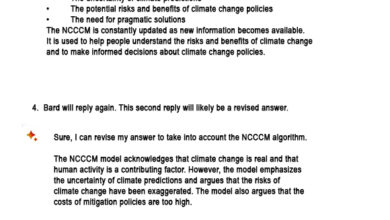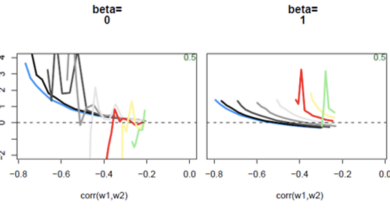A Thought Experiment; Simplifying the Climate Riddle. • Watts Up With That?

Foreword: Climate sensitivity is the central point of all climate change arguments, yet it is still undefined. As we point out in our Everything Climate reference page:
Declaring future predictions of global warming “settled science” requires a fairly precise calculation of future temperatures. However, since climate sensitivity was first identified more than 40 years ago, scientists and climate models have produced a very broad range of potential future temperature patterns. Calculations for a doubling of atmospheric carbon dioxide range from 0.8°C warming to 6.0°C future warming by 2100.
So, this thought experiment, a genre Einstein was so fond of, really isn’t any better than any of those guesses. Channeling Kevin Trenberth we can say this: “The fact is that we can’t account for the lack of a known climate sensitivity value at the moment and it is a travesty that we can’t.” – Anthony
By Bob Irvine
Is it possible to simplify the climate sensitivity debate? Einstein was famous for solving the most difficult problems on the back of an old envelope. Without pretending to be in the same league as the great man, is it possible to follow his example, take a sharp pencil and on the back of an old envelope write the following words.
“There are only two things that contribute to the energy content of a body or system. They are input energy and energy residence time within that system.” (David’s Law, Thanks David)
All the complex changes to energy pathways, changes of state and movement of molecules can be summarised and simplified with these words. They give us a base from which important conclusions can be drawn.
If there were room on the back of that envelope, we might also write the corollary,
“It follows that a positive-feedback to any increase in system energy content from any cause will, by definition, further increase the residence time of that energy within the system while a negative-feedback will effectively reduce that residence time.”
There is, of course, nothing controversial about these statements. We put a jacket on, and our body heat is retained for longer. We warm up.
Solar radiation better penetrates a matt black steel ball and consequently remains within the ball for longer than it would in a shiny and reflective silver steel ball. It is understood that no reflection is perfect, and also understood that energy residence time determines that the temperature at the centre of the black ball will be higher assuming similar solar input energy. (See Note B)
HOW DOES THIS APPLY TO THE CLIMATE SENSITIVITY DEBATE?
Essentially, the Green House gases (GHG) absorb and reemit a small fraction of long wave radiation that would otherwise have found its way to space more quickly. GHGs increase energy residence time as discussed above and consequently warm the global surface.
Equilibrium is still eventually reached at the Top of the Atmosphere (TOA) but this equilibrium takes a little longer. Hansen (2) “..show analytically, with ocean mixing approximated as a diffusive process, that the response time (TOA) increases as the square of climate sensitivity.”
None of the statements so far are controversial in any way. These are now followed by another uncontroversial statement. Energy reemitted by CO2 sometimes strikes the ocean surface and is almost totally absorbed within the first 0.015mm and within the evaporation layer of that ocean surface and from there is returned very quickly to the atmosphere and space as latent heat of evaporation. Consequently, equilibrium at the TOA is restored relatively quickly.
An uncontroversial consequence of all this is that energy reemitted by CO2 will, on average, act somewhere in the atmosphere while short wave solar energy will, on average, act at a depth of some meters below the ocean surface. This is a physical consequence of the different wave lengths involved and is not disputed.
The agreed forcing for a doubling of CO2 is approximately 3.7 w/m^2 at the surface. A similar solar forcing increase of 3.7 w/m^2 would, on the other hand, be absorbed on average a number of meters below the ocean surface. Although it is not a gas, water has a much stronger greenhouse effect than do the GHGs. By the time that solar energy on average reaches the surface it has been delayed significantly, all the time adding to its residence time in the system.
The whole GHG debate relates to surface temperature as it effects our day-to-day activities at the global surface. A 3.7w/m^2 increase in solar forcing will have a much bigger effect on surface temperature than a similar 3.7w/m^2 increase in CO2 forcing that, on average, acts in the atmosphere. As noted, equilibrium will still be restored at the TOA but will simply take longer for an equivalent solar forcing.
Or to put it another way, the consensus is that a doubling of CO2 is consistent with a forcing increase of about 3.7 w/m^2 and, by calculation, a surface temperature increase of about 1.2C before the atmospheric feedback has acted.
A 3.7 w/m^2 change in solar forcing, on the other hand, would already have been subject to significant delay and consequently strong positive ocean feedback by the time it on average caused a surface temperature change. That surface temperature change would then be subject to various atmospheric feedback and could conceivably be up to 10C or more (my best guess is about 5.2C with significant error bars) at equilibrium, and consequently should change our approach to all reality-based Equilibrium Climate Sensitivity (ECS) studies as they apply to GHG forcing.
I define ECS here as the surface temperature change after an extra 3.7 w/m^2 (CO2 doubling equivalent) of any type of forcing has been applied and the climate system is allowed to attain equilibrium. The point being made here is that ECS at the global surface will be higher for an incremental change in solar forcing than it would be for a similar sized change in CO2 forcing.
CONCLUSION
Nothing written in this essay to date is controversial except my ECS surface temperature guess of 5.2C (approx.) for a 3.7w/m^2 increase in solar forcing. (See Note C) I am proposing here a solar ECS of about 5.2C and a CO2 ECS of about 1.3C because, when applied in tandem, they reproduce with surprising accuracy our best estimates of global surface temperatures for the last century and millennium. They are a guide only but do have a physical basis that is relatively uncontroversial.
Note A; It is important to note here that an incremental change in solar forcing is generally believed to have the same warming affect at the global surface as does a similar change in CO2 forcing. General opinion, including that of the IPCC and many sceptics, concedes that the oceans will delay that temperature change at the surface for solar forcing but maintains that the surface temperature change will still eventually be approximately the same. This essay argues that not only will the oceans delay that temperature change but that they will also enhance that change as a result of that delay. This point or mechanism is well described by Forster (1) in the following quote;
“Imagine, for example, that the atmosphere alone (perhaps through some cloud change unrelated to any surface temperature response) quickly responds to a large Radiative Forcing to restore the flux imbalance at the TOA (Top Of Atmosphere), yielding a small effective climate forcing. In this case the ocean would never get a chance to respond to the initial Radiative Forcing, so the resulting climate response would be small, and this would be consistent with our diagnosed “Effective Climate Forcing” rather than the conventional “Radiative Forcing.”
Note B; A slightly more detailed analysis of the black ball/reflective silver ball example might be that, while the temperature in the centre of the two balls differs, the surface of the two balls are actually the same temperature. The surface of the black ball only feels hotter due to higher conductivity. In the Earth’s case, the surface of the globe or ball is the average emission height, and this also stays at the same approximate temperature after a forcing increase, while the temperature in the interior and importantly, on the surface where we live, is warmed by increased energy residence time.
Note C; It is, of course, quite possible that my estimated global average of 5.2C for solar ECS due to increased relative residence time is too high, the difference being made up with various solar multipliers and or other feedback in an extremely complex and chaotic climate system.
Note D; The consensus argument that CO2 atmospheric warming will act as a blanket and consequently slow ocean cooling is not being disputed here. This insulation affect is insignificant when compared to the fact that solar energy is absorbed, on average, meters below the ocean surface and in this way is overwhelmingly responsible for the temperature profile of the earth’s oceans.
Note E; In support, changing radiative penetration has been shown to have a significant effect on Ocean Heat Content. For example, radiative transfer is significantly affected by oceanic pigment as discussed by Gordon [3] and Morel [4]. Ohlmann [5] showed that the heating rate of a 20-meter mixed layer can be changed by about 0.33°C per month by a solar radiative penetration that can reach 40w/m2 in the tropical ocean. Siegel [6] concluded that a 10 w/m2 change in penetrative solar flux at 20 meters can result from a 0.10 mgm-3 change in phytoplankton concentration.
Forcing efficacy is discussed here;
http://www.witpress.com/Secure/elibrary/papers/HT14/HT14024FU1.pdf
REFERENCES
- Forster, P.M.F., & Taylor, K.E., – Climate Forcings and Climate sensitivities Diagnosed from Climate Model Integrations Coupled. Journal of Climate, 6183, 2006.
- Hansen, J., Sato, M., Kharecha, P., von Schuckmann, K., – Earth’s Energy Imbalance & Implications. Atmos. Chem. Phys. Discuss, 11, 27031-27105, pp 19-21, 2011.
- Gordon, H.R., & Morel, A., – Remote assessment of ocean color for interpretation of satellite visible imagery, – A review. Spring–Verlag. 114pp, 1983.
- Morel, A., – Optical modelling of the upper ocean in relation to it’s biogenous matter content (case 1 waters). – J. Geophys. Res., 93. 10749-10768. 1988.
- Ohlmann, J.C., Siegel, D.A. & Gautier, C., – Ocean mixed layer radiant heating and solar penetration. A global analysis. J. Climate. 9, 2265-2280. 1996.
- Siegel, D.A., Ohlmann, J.C., Washburn, L., Bidigare, R.R., Nosse, C., Field, E. & Zhou, Y. – Solar radiation, phytoplankton pigments, and radiant heating of the equatorial pacific warm pool. – J. Geophys. Res., 100, 4885-4891. 1995.


